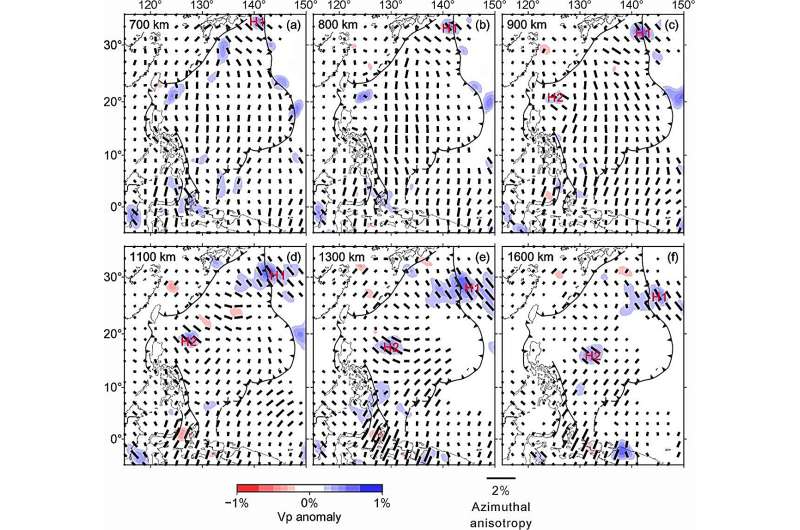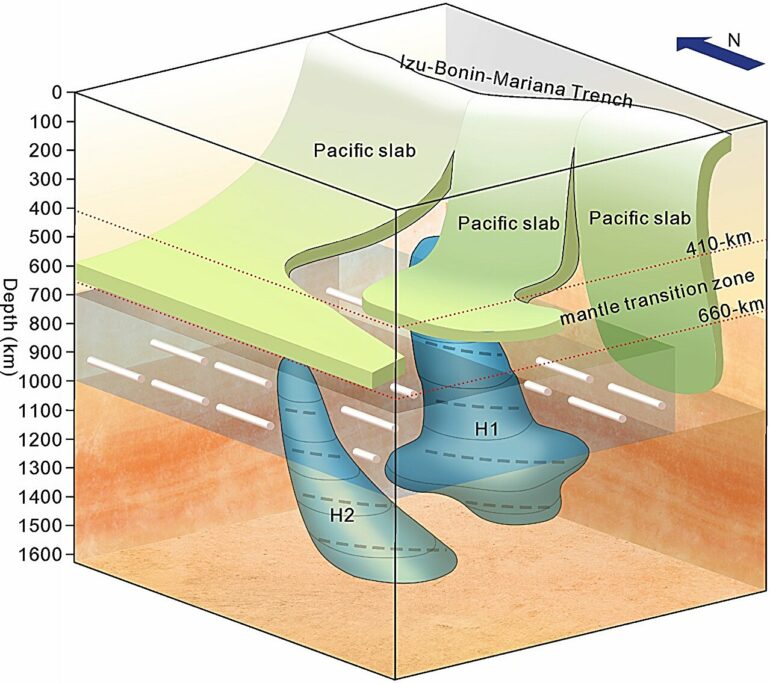Researchers from China and Japan have discovered distinct characteristics of Earth’s lower mantle flow field. They investigated seismic anisotropy in the upper part of the lower mantle beneath the Philippine Sea Plate (PSP) and found that the ancient lower mantle flow field is still preserved there.
The study is published in Nature Geoscience.
The lower mantle is an important layer of the Earth and may play an important role in the evolution and material cycling of Earth’s interior. It is generally believed to be not only the final destination of subducted slabs, but also the birthplace of mantle plumes, which are two major styles in the evolution and material cycling of the Earth’s surface and interior. However, our knowledge of the characteristics of the flow field and geodynamics of the lower mantle is still deficient.
In this study, the researchers performed P-wave azimuthal anisotropy tomography to image the 3D anisotropic structure of the crust and mantle down to a depth of 1,600 km beneath the PSP. The tomographic results show that N-S fast velocity directions (FVDs) exist at depths of 700–900 km below the mid-PSP. They also observed two isolated fast velocity anomalies with NW-SE FVDs at depths of 700–1,600 km beneath the PSP.
They found that the N-S FVDs at depths of 700–900 km are not related to the slab subduction, because they occur away from the present subduction zones. They are also independent of a mantle plume, as there has been no active mantle plume beneath the PSP since the early Cenozoic.

Map views of P-wave azimuthal anisotropic velocity tomography. The orientation and length of the black bars represent the fast velocity direction and amplitude of azimuthal anisotropy, respectively. © IOCAS
Based on previous geodynamic simulations and seismological results, the researchers inferred that the N-S FVDs at depths of 700–900 km reflect the remnant Pacific lower mantle flow field at about 50 Ma.
In addition, the two isolated fast velocity anomalies are consistent with seismic scatterers at depths of 1,000–1,800 km detected by previous seismological studies, and their locations are generally consistent with that of the spreading center between the Izanagi and Pacific plates when this spreading center was about to subduct beneath the Eurasian Plate. Thus, the isolated fast velocity anomalies are inferred to be remnants of the subducted Izanagi slab.
“The NW-SE FVDs in the two isolated fast anomalies are further inferred to reflect the Pacific lower mantle flow field at about 40 Ma, because the two isolated fast velocity anomalies are surrounded by amorphous mantle flow field and are not affected by the present lower mantle flow,” said Prof. Fan Jianke from the Institute of Oceanology of the Chinese Academy of Sciences (IOCAS), first and corresponding author of the study.
“Our study shows that seismic anisotropy is more widespread in the lower mantle than previously thought,” said Prof. Fan. “These observations also provide important and independent seismic evidence for the existence of past deformation in the lower mantle, which can help us better understand the geodynamic properties of the lower mantle.”
More information:
Remnants of shifting early Cenozoic Pacific lower mantle flow imaged beneath the Philippine Sea Plate, Nature Geoscience (2024). doi.org/10.1038/s41561-024-01404-6
Provided by
Chinese Academy of Sciences
Citation:
Seismological study shows ancient lower mantle flow field under Philippine sea plate (2024, March 12)



